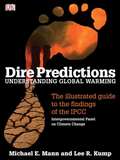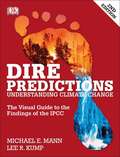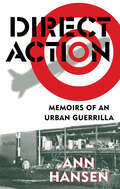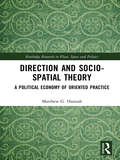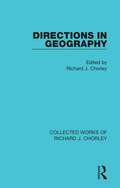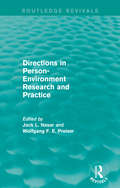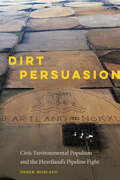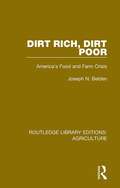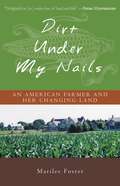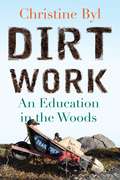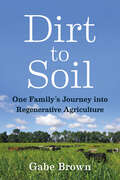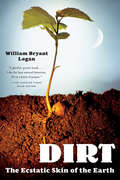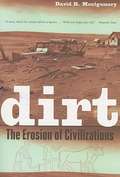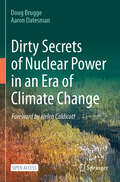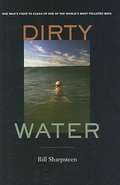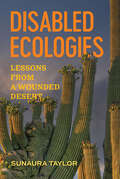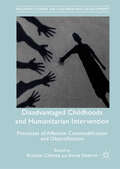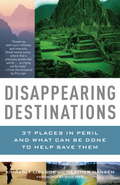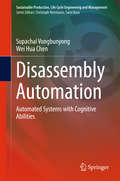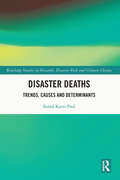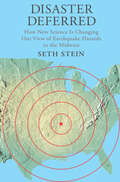- Table View
- List View
Dire Predictions
by Michael Mann Lee R. KumpInformation on global climate change drawn from the Fourth Assessment Report of the Intergovernmental Panel on Climate Change (IPCC).
Dire Predictions: Understanding Climate Change (Second Edition)
by Lee R. Kump Dorling Kindersley Publishing Staff Michael E. MannExplore global warming with graphics, illustrations, and charts that separate climate change fact from fiction, presenting the truth about global warming in a way that's both accurate and easy to understand. Respected climate scientists Michael E. Mann and Lee R. Kump address important questions about global warming and climate change, diving into the information documented by the IPCC (Intergovernmental Panel on Climate Change) and breaking it down into clear graphics that explain complex climate questions in simple illustrations that present the truth of the global warming problem clearly. These experts take scientific findings about climate change and global warming and use analogies, striking images, and understandable graphics to make the global warming question clear to both skeptics and scientists. Dire Predictions shows the evidence and the causes that respected scientists have documented in IPCC findings and climate change studies -- this powerful, illustrated book is updated with the latest IPCC information and is a must-read for anyone interested in understanding global warming and climate change and in joining the debate over the best way to combat global warming.
Direct Action: Memoirs of an Urban Guerrilla
by Ann HansenAnn Hansen stood trial as one of the so-called “Squamish Five.” Sentenced to life in prison, she served seven years. Now she tells her story for the first time. Direct Action captures the excitement and indignation of the counterculture of the early ’80s. Missile tests were fuelling a new arms race. Reckless megaprojects threatened the global environment. Alienation, punk rock, and militancy were on the rise. Hansen and her fellow urban guerrillas believed that sabotaging government and corporate property could help turn things around. To prove their point, they bombed the Litton Systems plant in Toronto, where components for Cruise Missiles were being made. Hansen’s book poses unresolved ethical dilemmas. In light of the recent explosion of anti-globalization protests, Direct Action mirrors the resurgence of militant activity around the world.
Direct and Indirect Human Contributions to Terrestrial Carbon Fluxes: A Workshop Summary
by Stephanie Johnson Rob CoppockHuman-induced climate change is an important environmental issue worldwide, as scientific studies increasingly demonstrate that human activities are changing the Earth’s climate. Even if dramatic reductions in emissions were made today, some human-induced changes are likely to persist beyond the 21st century. The Kyoto Protocol calls for emissions reporting that separates out management-induced changes in greenhouse gases from those changes caused by indirect human effects (e.g., carbon dioxide fertilization, nitrogen deposition, or precipitation changes), natural effects, and past practices on forested agricultural lands.This book summarizes a September 2003 workshop where leaders from academia, government and industry came together to discuss the current state of scientific understanding on quantifying direct human-induced change in terrestrial carbon stocks and related changes in greenhouse gas emissions and distinguishing these changes from those caused by indirect and natural effects.
Direct and Inverse Scattering for the Matrix Schrödinger Equation (Applied Mathematical Sciences #203)
by Tuncay Aktosun Ricardo WederAuthored by two experts in the field who have been long-time collaborators, this monograph treats the scattering and inverse scattering problems for the matrix Schrödinger equation on the half line with the general selfadjoint boundary condition. The existence, uniqueness, construction, and characterization aspects are treated with mathematical rigor, and physical insight is provided to make the material accessible to mathematicians, physicists, engineers, and applied scientists with an interest in scattering and inverse scattering. The material presented is expected to be useful to beginners as well as experts in the field. The subject matter covered is expected to be interesting to a wide range of researchers including those working in quantum graphs and scattering on graphs. The theory presented is illustrated with various explicit examples to improve the understanding of scattering and inverse scattering problems. The monograph introduces a specific class of input data sets consisting of a potential and a boundary condition and a specific class of scattering data sets consisting of a scattering matrix and bound-state information. The important problem of the characterization is solved by establishing a one-to-one correspondence between the two aforementioned classes. The characterization result is formulated in various equivalent forms, providing insight and allowing a comparison of different techniques used to solve the inverse scattering problem. The past literature treated the type of boundary condition as a part of the scattering data used as input to recover the potential. This monograph provides a proper formulation of the inverse scattering problem where the type of boundary condition is no longer a part of the scattering data set, but rather both the potential and the type of boundary condition are recovered from the scattering data set.
Direction and Socio-spatial Theory: A Political Economy of Oriented Practice (Routledge Research in Place, Space and Politics)
by Matthew G. HannahThe embodied directedness of human practice has long been neglected in critical socio-spatial theory, in favor of analyses focused upon distance and proximity. This book illustrates the absence of a sense for direction in much theoretical discourse and lays important groundwork for redressing this lacuna in socio-spatial theory. Many accounts of the social world are incomplete, or are increasingly out of step with recent developments of neoliberal capitalism. Not least through new technological mediations of production and consumption, the much-discussed waning of the importance of physical distance has been matched by the increasing centrality of turning from one thing to another as a basic way in which lives are structured and occupied. A sensibility for embodied processes of turning, and for phenomena of direction more generally, is urgently needed. Chapters develop wide-ranging and original engagements with the arguments of Sara Ahmed, Jonathan Beller, Edmund Husserl, Martin Heidegger, Virginia Held, Bernard Stiegler, Theodore Schatzki, Rahel Jaeggi, Hartmut Rosa and David Harvey. This book reinterprets practice, embodiment, alienation, reification, social reproduction and ethical responsibility from a directional perspective. It will be a new valuable resource and reference for political and social geography students, as well as sociologists and anthropologists.
Directions in Geography (Collected Works of Richard J. Chorley)
by Richard J. ChorleyOriginally published in 1973. This collection of essays looks at the ‘quantitative revolution’ and the ‘new geography’ by some of the geographers who had a significant part in those innovations and looks ahead to further developments. The views in the chapters are diverse and offer a fascinating glimpse of the discipline of geography as the subject was undergoing such change and becoming more socially committed. They cover theory, spatial-systems theory, forecasting, human ecology and climatology alongside the teaching of the subject. The concerns of the contemporary geographer come across and are of interest today as these areas have developed still more.
Directions in Person-Environment Research and Practice (Routledge Revivals)
by Wolfgang F.E. Preiser Jack L. NasarFirst published in 1999, this book presents a fresh and diverse set of perspectives representing key directions of research and practice in the field of environmental design research. Leading researchers in various areas of person-environment research, such as privacy, children’s environment, post-occupancy evaluation, environmental cognition, environmental aesthetics, crime prevention, housing and environmental protection and environmental design present what they consider their best work. The book argues for the value of a multi-disciplinary and interdisciplinary approach to problem-solving and outlines many important directions for methods, research and practice.
Dirt
by Steve TomecekBrief text explores how soil is formed, its layers, and its importance as a natural resource that living things need to survive.
Dirt Persuasion: Civic Environmental Populism and the Heartland's Pipeline Fight
by Derek MoscatoDirt Persuasion examines a watershed moment in U.S. environmental politics: the fight over the Keystone XL Pipeline. The complex interplay of resources extraction industries with grassroots environmentalism and advocacy has transformed the role of activists in the contemporary public sphere. Bold Nebraska&’s years-long fight against pipeline company TransCanada provides a compelling case study: a contemporary state-level organization that simultaneously challenged political and business leaders in its home state of Nebraska, at the national level in the United States, and in the foreign jurisdiction of Canada.Dirt Persuasion sheds light not only on the activism practices of social movements but also on the changing environments in which such actions are deployed. The KXL Pipeline fight represents a watershed moment both for U.S. energy politics and in the communication of environmental activism. The rural dimension of this environmental saga is critical: environmentalism must be understood from the perspective of the rural Americans who coexist with one of the planet&’s most delicate ecologies. Populism, rhetorical appeals, strategic advocacy framing, and media framing all factor prominently within the pipeline debate—leading to a civic environmental persuasion built on the attributes of narrative, engagement, hyperlocalization, and bipartisanship in order to build broad stakeholder support and influence public policy.
Dirt Rich, Dirt Poor: America's Food and Farm Crisis (Routledge Library Editions: Agriculture #9)
by Lynn Parker Alan Sanders Joseph N. Belden Vincent P. Wilber Enid Kassner Rus Sykes Ed Cooney Cynthia Schneider Marsha SimonThis book, first published in 1986, is a major reference work for the political discussions arising out of the 1985 Congress revisions of US food and farm laws. It covers production, distribution and consumption of food, analyses international as well as domestic problems, and presents new ways forward. Emphasising public policy and programmes, the book has chapters on agricultural production; environmental and resource problems; food marketing; domestic hunger and nutrition; and world hunger and development.
Dirt Under My Nails: An American Farmer and Her Changing Land
by Marilee FosterA woman farmer observes with a poetic and appreciative eye the transformation of the plant and animal life on her land through the changing seasons, and now through the encroachment of residential development.
Dirt Work: An Education in the Woods
by Christine BylA lively and lyrical account of one woman's unlikely apprenticeship on a national-park trail crew and what she discovers about nature, gender, and the value of hard work Christine Byl first encountered the national parks the way most of us do: on vacation. But after she graduated from college, broke and ready for a new challenge, she joined a Glacier National Park trail crew as a seasonal "traildog" maintaining mountain trails for the millions of visitors Glacier draws every year. Byl first thought of the job as a paycheck, a summer diversion, a welcome break from "the real world" before going on to graduate school. She came to find out that work in the woods on a trail crew was more demanding, more rewarding--more real--than she ever imagined. During her first season, Byl embraces the backbreaking difficulty of the work, learning how to clear trees, move boulders, and build stairs in the backcountry. Her first mentors are the colorful characters with whom she works--the packers, sawyers, and traildogs from all walks of life--along with the tools in her hands: axe, shovel, chainsaw, rock bar. As she invests herself deeply in new work, the mountains, rivers, animals, and weather become teachers as well. While Byl expected that her tenure at the parks would be temporary, she ends up turning this summer gig into a decades-long job, moving from Montana to Alaska, breaking expectations--including her own--that she would follow a "professional" career path. Returning season after season, she eventually leads her own crews, mentoring other trail dogs along the way. In Dirt Work, Byl probes common assumptions about the division between mental and physical labor, "women's work" and "men's work," white collars and blue collars. The supposedly simple work of digging holes, dropping trees, and blasting snowdrifts in fact offers her an education of the hands and the head, as well as membership in an utterly unique subculture. Dirt Work is a contemplative but unsentimental look at the pleasures of labor, the challenges of apprenticeship, and the way a place becomes a home.
Dirt to Soil: One Family's Journey into Regenerative Agriculture
by Gabe Brown&“A regenerative no-till pioneer.&”—NBC News&“We need to reintegrate livestock and crops on our farms and ranches, and Gabe Brown shows us how to do it well.&”—Temple Grandin, author of Animals in Translation&“Dirt to Soil is the [regenerative farming] movements&’s holy text.&”—The ObserverGabe Brown didn&’t set out to change the world when he first started working alongside his father-in-law on the family farm in North Dakota. But as a series of weather-related crop disasters put Brown and his wife, Shelly, in desperate financial straits, they started making bold changes to their farm. Brown—in an effort to simply survive—began experimenting with new practices he&’d learned about from reading and talking with innovative researchers and ranchers. As he and his family struggled to keep the farm viable, they found themselves on an amazing journey into a new type of farming: regenerative agriculture.Brown dropped the use of most of the herbicides, insecticides, and synthetic fertilizers that are a standard part of conventional agriculture. He switched to no-till planting, started planting diverse cover crops mixes, and changed his grazing practices. In so doing Brown transformed a degraded farm ecosystem into one full of life—starting with the soil and working his way up, one plant and one animal at a time.In Dirt to Soil Gabe Brown tells the story of that amazing journey and offers a wealth of innovative solutions to restoring the soil by laying out and explaining his &“five principles of soil health,&” which are:Limited DisturbanceArmorDiversityLiving RootsIntegrated AnimalsThe Brown&’s Ranch model, developed over twenty years of experimentation and refinement, focuses on regenerating resources by continuously enhancing the living biology in the soil. Using regenerative agricultural principles, Brown&’s Ranch has grown several inches of new topsoil in only twenty years! The 5,000-acre ranch profitably produces a wide variety of cash crops and cover crops as well as grass-finished beef and lamb, pastured laying hens, broilers, and pastured pork, all marketed directly to consumers.The key is how we think, Brown says. In the industrial agricultural model, all thoughts are focused on killing things. But that mindset was also killing diversity, soil, and profit, Brown realized. Now he channels his creative thinking toward how he can get more life on the land—more plants, animals, and beneficial insects. &“The greatest roadblock to solving a problem,&” Brown says, &“is the human mind.&”See Gabe Brown―author and farmer―in the award-winning documentaries Kiss the Ground and Common Ground!
Dirt: The Ecstatic Skin of the Earth
by William Bryant Logan"A gleeful, poetic book. . . . Like the best natural histories, Dirt is a kind of prayer." --Los Angeles Times Book Review "You are about to read a lot about dirt, which no one knows very much about." So begins the cult classic that brings mystery and magic to "that stuff that won't come off your collar." John Adams, Thomas Jefferson, Saint Phocas, Darwin, and Virgil parade through this thought-provoking work, taking their place next to the dung beetle, the compost heap, dowsing, historical farming, and the microscopic biota that till the soil. With fresh eyes and heartfelt reverence, William Bryant Logan variously observes, "There is glamour to the study of rock"; "The most mysterious place on Earth is right beneath our feet"; and "Dirt is the gift of each to all." Whether Logan is traversing the far reaches of the cosmos or plowing through our planet's crust, his delightful, elegant, and surprisingly soulful meditations greatly enrich our concept of "dirt," that substance from which we all arise and to which we all must return.
Dirt: The Erosion of Civilizations
by David R. MontgomeryThis fascinating book finds that we are running out of dirt, and it's no laughing matter. An engaging natural and cultural history of soil that sweeps from ancient civilizations to modern times, Dirt: The Erosion of Civilizations explores the compelling idea that we are--and have long been--using up Earth's soil.
Dirty Secrets of Nuclear Power in an Era of Climate Change
by Doug Brugge Aaron DatesmanThis open access book provides a review of the serious limitations and drawbacks to nuclear power, and clearly conveys why nuclear power is a less than desirable option in terms of addressing climate change. It uses accessible and engaging language to help bring an understanding of the issues with nuclear power to a broader sector of the public, with the intention of appealing to non-scientists seeking knowledge on the disadvantages of nuclear power as a solution for climate change. The argument is made that while superficially appealing, nuclear power is too costly, fragile, and slow to implement, compared to alternative options such as wind and solar. “As this book shows, to nowadays hold on to Nuclear Energy, a risky and extremely expensive method of create power, just does not make sense any longer.” -- Prof. (em.) Andreas Nidecker, MD, retired academic radiologist, Basel, Switzerland “Datesman and Brugge present evidence that nuclear power is an insecure and unsecureable technology, inherently incompatible with humanity and democracy; it fuels nuclear weapons technology and possession; choosing it would damage our chances at mitigating the climate crisis.” -- Cindy Folkers, MS, Radiation & Health Specialist, Beyond Nuclear “Although the government, industrial, and scientific nexus say it is safe.…I can only think of one word in Navajo "Ina'adlo'" meaning manipulation by the power that be to say it is safe. My Navajo people are dying from the uranium exposure on their health and environment. Great account of information on studies that have taken place around the world to say uranium is not good.” – Esther Yazzie, Navajo Interpreter and knowledge holder on Navajo issues. “At a time when there is a call to triple the growth of nuclear power, Datesman and Brugge provide a timely and thorough examination of the dark-side of “romancing” the atom. With solid technical astuteness, they cover a wide field littered with unsolved and dangerous problems ranging from the poisoning of people and the environment to the failed economics, to the spread of nuclear weapons ….they point out how science and public trust have been corrupted by the lure of unfettered nuclear growth.” –Robert Alvarez, Associate Fellow at the Institute for Policy Studies in Washington, D.C.
Dirty Water: One Man’s Fight to Clean Up One of the World’s Most Polluted Bays
by Bill SharpsteenDirty Water is the riveting story of how Howard Bennett, a Los Angeles schoolteacher with a gift for outrageous rhetoric, fought pollution in Santa Monica Bay--and won.
Disabled Ecologies: Lessons from a Wounded Desert
by Sunaura Taylor"With breath-catching insight and enveloping compassion, Sunaura Taylor shares a secret of epochal urgency: people living with injury and impairment have much to teach about how to survive, and perhaps even thrive, on an injured and impaired planet."—Naomi Klein, author of Doppelganger A powerful analysis and call to action that reveals disability as one of the defining features of environmental devastation and resistance. Deep below the ground in Tucson, Arizona, lies an aquifer forever altered by the detritus of a postwar Superfund site. Disabled Ecologies tells the story of this contamination and its ripple effects through the largely Mexican American community living above. Drawing on her own complex relationship to this long-ago injured landscape, Sunaura Taylor takes us with her to follow the site's disabled ecology—the networks of disability, both human and wild, that are created when ecosystems are corrupted and profoundly altered. What Taylor finds is a story of entanglements that reach far beyond the Sonoran Desert. These stories tell of debilitating and sometimes life-ending injuries, but they also map out alternative modes of connection, solidarity, and resistance—an environmentalism of the injured. An original and deeply personal reflection on what disability means in an era of increasing multispecies disablement, Disabled Ecologies is a powerful call to reflect on the kinds of care, treatment, and assistance this age of disability requires.
Disadvantaged Childhoods and Humanitarian Intervention: Processes of Affective Commodification and Objectification (Palgrave Studies on Children and Development)
by Kristen Cheney Aviva SinervoThis book explores how humanitarian interventions for children in difficult circumstances engage in affective commodification of disadvantaged childhoods. The chapters consider how transnational charitable industries are created and mobilized around childhood need—highlighting children in situations of war and poverty, and with indeterminate access to health and education—to redirect global resource flows and sentiments in order to address concerns of child suffering. The authors discuss examples from around the world to show how, as much as these processes can help achieve the goals of aid organizations, such practices can also perpetuate the conditions that organizations seek to alleviate and thereby endanger the very children they intend to help.
Disappearing Destinations
by Kimberly Lisagor Heather HansenA beautiful and memorable look at some of the most gorgeous endangered places on the planet. Machu Picchu is a mesmerizing, ancient Incan city tucked away in the mountains of Peru, but it is rapidly being worn down by the thousands of feet treading across its stones. Glacier National Park is a destination long known for the stunning beauty of its ice floes, but in our lifetimes it will have no glaciers due to global warming. In the biobays of Puerto Rico swimmers can float in a sea shimmering with bioluminescent life, but sediment being churned up by development is killing the dinoflagellates that produce the eerie and beautiful glow. And in the Congo Basin of Africa, where great apes roam freely in lush, verdant rainforests, logging is quickly destroying the vast life-giving canopies. These places-along with many others across the globe-are changing as we speak due to global warming, environmental degradation, overuse, and natural causes. From the Boreal Forests in Finland to the Yangtze River Valley in China,37 Places to See Before They Disappearis a treasure trove of geographic wonder, and a guide to these threatened destinations and what is being done to save them.
Disassembled Cities: Social and Spatial Strategies to Reassemble Communities (Global Urban Studies)
by Elizabeth L. SweetThis book explores the urban, political, and economic effects of contemporary capitalism as well being concerned with a collective analytic that addresses these processes through the lens of disassembling and reassembling dynamics. The processes of contemporary globalization have resulted in the commodification of various dimensions that were previously the domain of state action. This book evaluates the varying international responses from communities as they cope and confront the negative impacts of neoliberalism. In-depth case studies from scholars working in Europe, Latin America, Africa, and Asia showcase how various cities are responding to the effects of neoliberalism. Chapters investigate and demonstrate how the neoliberal processes of dissembling are being countered by positive and engaged efforts of reassembly. From Colombia to Siberia, Chicago to Nigeria, contributions engage with key economic and urban questions surrounding the militarization of state, democracy, the rise of the global capital and the education of young people in slums. This book will have a broad appeal to academic researchers and urban planning professionals. It is recommended core reading for students in Urban Planning, Geography, Sociology, Anthropology, and Urban Studies.
Disassembly Automation
by Supachai Vongbunyong Wei Hua ChenThis book presents a number of aspects to be considered in the development of disassembly automation, including the mechanical system, vision system and intelligent planner. The implementation of cognitive robotics increases the flexibility and degree of autonomy of the disassembly system. Disassembly, as a step in the treatment of end-of-life products, can allow the recovery of embodied value left within disposed products, as well as the appropriate separation of potentially-hazardous components. In the end-of-life treatment industry, disassembly has largely been limited to manual labor, which is expensive in developed countries. Automation is one possible solution for economic feasibility. The target audience primarily comprises researchers and experts in the field, but the book may also be beneficial for graduate students.
Disaster Deaths: Trends, Causes and Determinants (Routledge Studies in Hazards, Disaster Risk and Climate Change)
by Bimal Kanti PaulThis book conducts a systematic inquiry into the tragic deaths caused by natural disasters at different geographic scales. It employs key disaster concepts and classification of disasters to understand the high mortality rates and the various factors associated with these deaths. Deaths are the direct and immediate impact of disaster events, which have remained a major concern for disaster managers and policy-makers all over the world. Using primary research and secondary data, this book provides a comprehensive analysis of various facets of disaster deaths such as trends, circumstances and causes, and determinants at global, regional, national, and subnational scales. It offers a holistic perspective on disaster mortality, which has been lacking for some time. The book not only fills this research gap but also suggests important policy implications for disaster managers and policy makers working in multilateral, bilateral, local, and international nongovernmental organizations (NGOs). These policies include effective strategies to significantly reduce the risk of deaths caused by natural disasters, which are explored through chapters written in a clear and accessible style. Drawing together the case studies on past major disasters as well as recent ones, the book provides new and critical insights into deaths precipitated by natural disasters. Suitable for both technical and nontechnical readers, the book has a broader appeal and will thus be useful for practitioners, researchers, students, as well as activists in the area of hazards and disasters who are interested in studying mortality due to extreme natural events.
Disaster Deferred: A New View of Earthquake Hazards in the New Madrid Seismic Zone
by Seth SteinIn the winter of 1811-12, a series of large earthquakes in the New Madrid seismic zone-often incorrectly described as the biggest ever to hit the United States-shook the Midwest. Today the federal government ranks the hazard in the Midwest as high as California's and is pressuring communities to undertake expensive preparations for disaster. Coinciding with the two-hundredth anniversary of the New Madrid earthquakes, Disaster Deferred revisits these earthquakes, the legends that have grown around them, and the predictions of doom that have followed in their wake. Seth Stein clearly explains the techniques seismologists use to study Midwestern quakes and estimate their danger. Detailing how limited scientific knowledge, bureaucratic instincts, and the media's love of a good story have exaggerated these hazards, Stein calmly debunks the hype surrounding such predictions and encourages the formulation of more sensible, less costly policy. Powered by insider knowledge and an engaging style, Disaster Deferred shows how new geological ideas and data, including those from the Global Positioning System, are painting a very different-and much less frightening-picture of the future.
